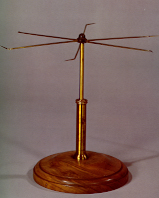
22.3 x 27.3
Brass and wood
CAT. 1878 : 358
Torniquete electrico.
Electric turnstile.
Some of the experiments carried out in electrostatic in the 18th century were related to the study of the effect of points. Instruments with very finely pointed metal conductors were thus developed. The electric turnstile is one such instrument.
The turnstile in the Gabinete de Física at Coimbra has six brass spikes symmetrically arranged radiating from a small insulator disc. All the spikes have the points bent in the same direction. This set is placed on the top of a vertical pointed brass rod standing on a circular wooden base.
When it is charged by an electrostatic machine, the turnstile begins to rotate on its vertical axis. This behaviour can be explained by the "electric wind" generated by the points, where the density of the charge is high.
The explanation of the turnstile's behaviour in the context of "electrical fluids" arose as an analogy to the behaviour of a hydraulic turnstile reacting to the action of a weighable fluid.
Sigaud de la Fond, Joseph-Aignan, Description et Usage d'un Cabinet de Physique Expérimentale, 1775, Vol. II, Pl. XXIII.